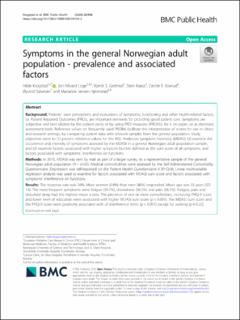| dc.contributor.author | Krogstad, Hilde | |
| dc.contributor.author | Loge, Jon Håvard | |
| dc.contributor.author | Grotmol, Kjersti S. | |
| dc.contributor.author | Kaasa, Stein | |
| dc.contributor.author | Kiserud, Cecilie E. | |
| dc.contributor.author | Salvesen, Øyvind | |
| dc.contributor.author | Hjermstad, Marianne Jensen | |
| dc.date.accessioned | 2020-08-18T08:48:29Z | |
| dc.date.available | 2020-08-18T08:48:29Z | |
| dc.date.created | 2020-07-22T11:49:31Z | |
| dc.date.issued | 2020 | |
| dc.identifier.citation | BMC Public Health. 2020, 20 (988), . | en_US |
| dc.identifier.issn | 1471-2458 | |
| dc.identifier.uri | https://hdl.handle.net/11250/2672731 | |
| dc.description.abstract | Background
Patients´ own perceptions and evaluations of symptoms, functioning and other health-related factors, i.e. Patient Reported Outcomes (PROs), are important elements for providing good patient care. Symptoms are subjective and best elicited by the patient orally or by using PRO measures (PROMs), be it on paper, or as electronic assessment tools. Reference values on frequently used PROMs facilitate the interpretation of scores for use in clinics and research settings, by comparing patient data with relevant samples from the general population. Study objectives were to (1) present reference values for the M.D. Anderson Symptom Inventory (MDASI) (2) examine the occurrence and intensity of symptoms assessed by the MDASI in a general Norwegian adult population sample, and (3) examine factors associated with higher symptom burden defined as the sum score of all symptoms, and factors associated with symptoms` interference on functions.
Methods
In 2015, MDASI was sent by mail as part of a larger survey, to a representative sample of the general Norwegian adult population (N = 6165). Medical comorbidities were assessed by the Self-Administered Comorbidity Questionnaire. Depression was self-reported on the Patient Health Questionnaire 9 (PHQ-9). Linear multivariable regression analysis was used to examine for factors associated with MDASI sum score and factors associated with symptoms’ interference on functions.
Results
The response rate was 36%. More women (54%) than men (46%) responded. Mean age was 55 years (SD 14). The most frequent symptoms were fatigue (59.7%), drowsiness (56.2%) and pain (56.1%). Fatigue, pain and disturbed sleep had the highest mean scores. The presence of one or more comorbidities, increasing PHQ-9 score and lower level of education were associated with higher MDASI sum score (p < 0.001). The MDASI sum score and the PHQ-9 score were positively associated with all interference items (p < 0.001) except for walking (p = 0.22).
Conclusion
This study provides the first Norwegian reference values for MDASI. The presence of one or more comorbidities, higher level of depressive symptoms and lower level of education were significantly associated with higher MDASI sum score. These covariates must be controlled for when using the reference values. | en_US |
| dc.language.iso | eng | en_US |
| dc.publisher | BioMed Central | en_US |
| dc.rights | Navngivelse 4.0 Internasjonal | * |
| dc.rights.uri | http://creativecommons.org/licenses/by/4.0/deed.no | * |
| dc.title | Symptoms in the general Norwegian adult population - prevalence and associated factors | en_US |
| dc.type | Peer reviewed | en_US |
| dc.type | Journal article | en_US |
| dc.description.version | publishedVersion | en_US |
| dc.source.pagenumber | 0 | en_US |
| dc.source.volume | 20 | en_US |
| dc.source.journal | BMC Public Health | en_US |
| dc.source.issue | 988 | en_US |
| dc.identifier.doi | 10.1186/s12889-020-09109-2 | |
| dc.identifier.cristin | 1820175 | |
| dc.description.localcode | Open Access This article is licensed under a Creative Commons Attribution 4.0 International License, which permits use, sharing, adaptation, distribution and reproduction in any medium or format, as long as you give appropriate credit to the original author(s) and the source, provide a link to the Creative Commons licence, and indicate if changes were made. The images or other third party material in this article are included in the article's Creative Commons licence, unless indicated otherwise in a credit line to the material. If material is not included in the article's Creative Commons licence and your intended use is not permitted by statutory regulation or exceeds the permitted use, you will need to obtain permission directly from the copyright holder. To view a copy of this licence, visit http://creativecommons.org/licenses/by/4.0/. The Creative Commons Public Domain Dedication waiver (http://creativecommons.org/publicdomain/zero/1.0/) applies to the data made available in this article, unless otherwise stated in a credit line to the data. | en_US |
| cristin.ispublished | true | |
| cristin.fulltext | original | |
| cristin.qualitycode | 1 | |

